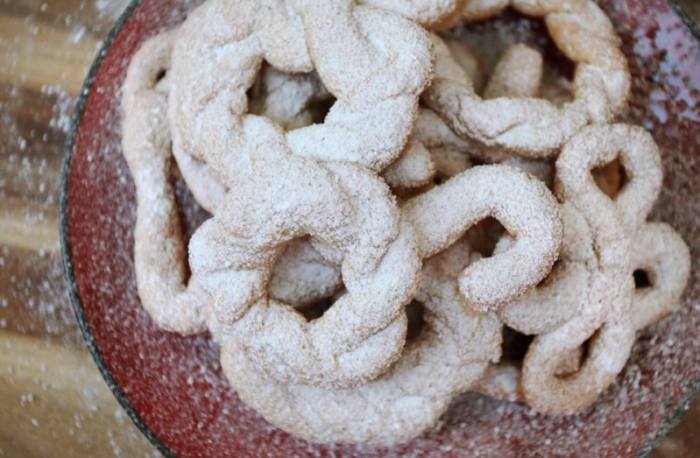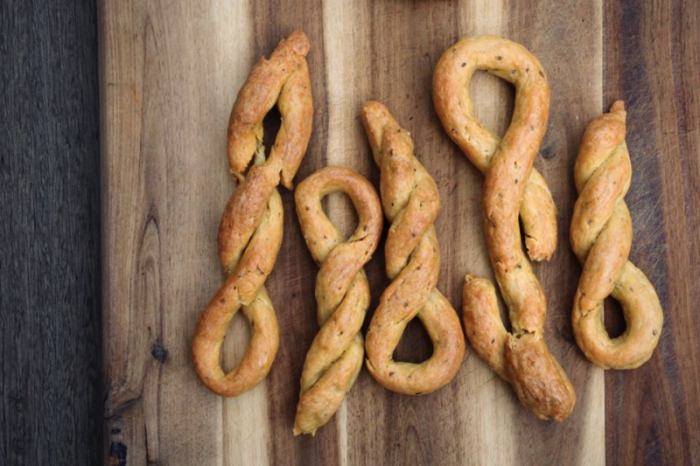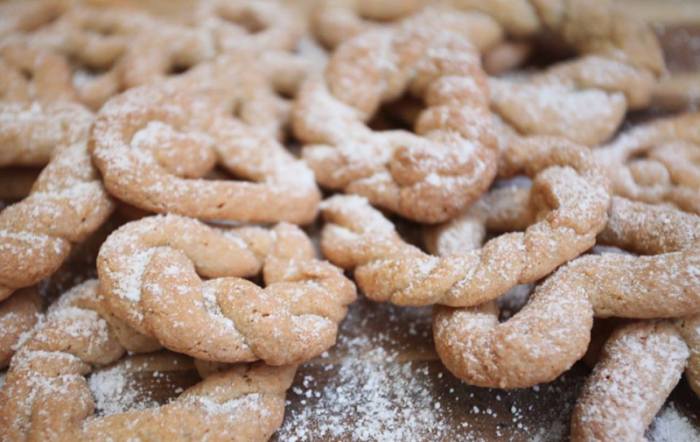If you’ve ever flicked through a historical cookbook you may have stumbled across a recipe for jumbles (also spelt jumbals, iombils, jambals and any other way you can imagine), a popular type of biscuit from the 16th century onwards. When I first heard about jumbles I, like many other people I think, was under the impression that they were called jumbles because they were a jumble of ingredients, but in fact the name refers to their shape.
In 16th century England gimmell rings (from the Latin gemellus for twin) were popular symbols of love and friendship and often exchanged as wedding rings. The rings were made of two or more intersecting bands which could be separated to form two separate rings, worn by each party during the betrothal period and then re-joined during the wedding.[1] Many of these rings exist in museum collections, and they are also celebrated in the literature of the day. I particularly like Robert Herrick’s poem The Jimmall Ring Or True-Love Knot:
“Thou sent’st to me a true love-knot, but I
Returned a ring of jimmals to imply
Thy love had one knot, mine a triple tie.”[2]
Jumbles then are biscuits made in the shape of these rings, and their twisted and entwined shapes are easily recognisable in many 16th and 17th century paintings, only recently has their shape changed to a flat or mounded biscuit. What is less sure is what exactly they should be made of. In fact, there is a huge amount of variation over the centuries.
![Still life with Venetian Glass, a romer and a candle by Clara Peeters, 1607. [Public domain], via Wikimedia Commons](https://turnspitandtable.files.wordpress.com/2015/02/clara_peeters_stillleben.jpg?w=800&resize=700%2C566)
Still life with Venetian Glass, a romer and a candle by Clara Peeters, 1607. [Public domain], via Wikimedia Commons
Early jumble recipes, such as those from Thomas Dawson’s The Good Huswife’s Jewell from 1597 are biscuits flavoured with aniseed and rosewater and formed into knots before being boiled and baked.[3] Martha Washington’s Cookbook which, according to Karen Hess, probably dates from the second half of the 17th century contains a similar recipe which is even more heavily spiced (with carraway, aniseed, rosewater, musk and ambergris) but is not boiled.[4] However, it also has recipes for jumbles made from marzipan and baked fruit paste, as well as one for Lemon Jumbles which Hess notes is more like a meringue. Published in 1741 Elizabeth Moxon’s book English Housewifery Exemplified also offer both biscuit and fruit paste versions (from apricots, or she gives the option of making Barberry Cakes in the form of jumbles).[5]
Jumbles held on well into the 19th century, although the flavouring had become more familiar with cinnamon, nutmeg and lemon amongst the most popular additions. The shapes were also probably less complex, being formed into little rings or simply rolled out and baked thin. Whilst Elizabeth Lea’s book Domestic Cookery, Useful Receipts, and Hints to Young Housekeepers (1859) offered a selection of recipes (Rich Jumbles, Common Jumbles, Molasses Jumbles, Jumbles for Delicate Persons, Cup Jumbles and Jackson Jumbles)[6], other sources had pared their recipes back to the bare minimum. A recipe from 1860 runs “Jumbles. Half a pound of sugar. Half a pound of butter. Half a pound of flour. Flavour with cinnamon.”[7] In Australia references to honey jumbles appear in newspapers around the turn of the 20th century, often referring to American recipes or producers. A version of these is still produced by Arnott’s today, but these soft, gingerbready biscuits bear little resemblance to any other type of jumbles in either their shape or ingredients. For an example of this type of recipe see here.
The Recipes
I used two different recipes for jumbles, one is for a savoury more bread-like type of jumbles, pleasantly flavoured with aniseed and boiled before baking (like a modern bagel or pretzel).
“To Make Jambals : Take a pint of fine wheat flour, the yolks of three or four new laid eggs, three or four spoonfuls of sweet cream, a few anniseeds, and some cold butter, make it into paste, and roul it into long rouls, as big as a little arrow, make them into divers knots, then boil them in fair water like simnels; bake them, and being baked, box them and keep them in a stove. Thus you may use them, and keep them all the year.”[8]
I had a bit of difficulty shaping these because of the texture of the dough, and I think that they could probably use some salt, or at the least salted butter, to give them a little more flavour. The lack of salt in the recipe does confuse me a bit, given that May suggests you can keep them for a whole year. Possibly the salt was assumed in the recipe? The second recipe that I used was for a slightly chewy biscuit, also flavoured with aniseed. These were really good and I would definitely recommend the recipe.
“To make Iumbals. To make the best Iumbals, take the whites of three egges and beate them well, and take of the viell; then take a little milke and a pound of fine wheat flower and sugar together finely sifted, and a few Aniseeds well rubd and dried; and then make what formes you please ; & bake them in a soft ouen vpon white Papers.”[9]
The Redactions
To Make Jambals (the savoury bread type)
250g flour
2 tsp aniseeds, ground to a powder in a mortar and pestle
60g salted butter
4 egg yolks
4 tbsp cream
- Place the flour and aniseed in a bowl and mix together. Rub in the butter until it is like breadcrumbs then stir in the egg yolks and cream until combined. If necessary add a little egg white to soften the mixture.
- Take walnut sized pieces of dough and roll into sausages the thickness of a pencil. The dough gets air pockets in the middle which makes it difficult to roll but by applying downward pressure with your palms as you roll you can form sausages. Fold the sausage in half and twist the ends together or form into other shapes as desired.
- Preheat the oven to 180˚C. Bring a wide saucepan of water to rolling boil and carefully place the jumbles into the boiling water with a slotted spoon. Allow them to boil in the liquid for 1 minute then scoop them out and place them on a baking tray lined with baking paper. Bake for 25-30 minutes or until golden brown.
To Make Jumbals (the sweet biscuit type)
3 egg whites
6 tbsp milk
225g plain flour
225 wholemeal flour
450g sugar
3 tsp aniseeds, ground to a powder in a mortar and pestle
- Preheat the oven to 180˚C. Beat the egg whites until fluffy then stir in the milk, flour, sugar and aniseeds until they form a dough.
- On a floured board shape pieces of dough into knots, hearts, letters etc. Place them on a baking tray lined with baking paper and cook in the oven for 20 minutes or until lightly golden.
The Round-up
The Recipe: Jambals from The Accomplisht Cook by Robert May (available here)
The Date:1685
How did you make it?
Time to complete?: About an hr.
How successful was it?: More successful that I was expecting, at first I was really struggling to get the dough to stick together but by applying downwards pressure with my palms as I rolled, and adding a little egg white, I was able to get it to work. The larger twists fell apart a big during boiling, but the smaller ones stayed together really well. The flavour was quite subtle, and considering how long they are supposed to stay good, I was surprised at the lack of salt. Very different from the other jumbles, savoury rather than sweet but quite tasty.
How accurate?: Not too bad I think, although I don’t know how long I should have boiled it for, I just guessed that. I’d also like to know how long they do keep, and what it means to box them and keep them in a stove.
The Recipe: Jumbals from Country Contentements by Gervase Markham (available here)
The Date:1623
How did you make it?
Time to complete?: About an hr.
How successful was it?: Very successful, gave a light slightly chewy biscuit lightly flavoured with aniseed.
How accurate?: I wasn’t quite sure what it meant to “take of the viell” so I just whipped the egg whites until fluffy. It seemed to work well.
[1] The British Museum, “Fede Ring/gimmel-Ring,” The British Museum Collection Online, accessed February 9, 2015, http://www.britishmuseum.org/research/collection_online/collection_object_details.aspx?objectId=79510&partId=1.
[2] Robert Herrick, The Hesperides & Noble Numbers, ed. Alfred Pollard, vol. 1 (London and New York: Lawrence & Bullen, Ltd., 1898), 217.
[3] Thomas Dawson, The Second Part of the Good Hus-Wifes Jewell (London: Printed by E. Allde for Edward White, 1597), 19.
[4] Karen Hess, Martha Washington’s Booke of Cookery and Booke of Sweetmeats, Reprint edition (New York: Columbia University Press, 1996), 348–351.
[5] Elizabeth Moxon, English Housewifry Exemplified (Leeds: Printed by J. Lister, and sole by J. Swale, J. Ogle, and S. Howgate, at Leeds; J. Lord at Wakefield; and the author at Pontefract., 1741), 139 & 175.
[6] Elizabeth E. Lea, Domestic Cookery, Useful Receipts, and Hints to Young Housekeepers (Baltimore: Cushings and Bailey, 1859), 118–119.
[7] Luther Tucker and Son and J.J Thomas, eds., The Country Gentleman, vol. 15 (Albany: Luther Tucker, 1860), 383.
[8] Robert May, The Accomplisht Cook, Or, The Art and Mystery of Cookery. (London: printed by R.W. for Nath: Brooke, 1660), 275.
[9] Gervase Markham, Countrey Contentments, or the English Huswife: Containing the Inward and Outward Vertues Which out to Be in a Compleate Woman (London: Printed for R. Jackson, 1623), 114.
Bibliography
Dawson, Thomas. The Second Part of the Good Hus-Wifes Jewell. London: Printed by E. Allde for Edward White, 1597.
Herrick, Robert. The Hesperides & Noble Numbers. Edited by Alfred Pollard. Vol. 1. London and New York: Lawrence & Bullen, Ltd., 1898.
Hess, Karen. Martha Washington’s Booke of Cookery and Booke of Sweetmeats. Reprint edition. New York: Columbia University Press, 1996.
Lea, Elizabeth E. Domestic Cookery, Useful Receipts, and Hints to Young Housekeepers. Baltimore: Cushings and Bailey, 1859.
Markham, Gervase. Countrey Contentments, or the English Huswife: Containing the Inward and Outward Vertues Which out to Be in a Compleate Woman. London: Printed for R. Jackson, 1623.
May, Robert. The Accomplisht Cook, Or, The Art and Mystery of Cookery. London: printed by R.W. for Nath: Brooke, 1660.
Moxon, Elizabeth. English Housewifry Exemplified. Leeds: Printed by J. Lister, and sole by J. Swale, J. Ogle, and S. Howgate, at Leeds; J. Lord at Wakefield; and the author at Pontefract., 1741.
The British Museum. “Fede Ring/gimmel-Ring.” The British Museum Collection Online. Accessed February 9, 2015. http://www.britishmuseum.org/research/collection_online/collection_object_details.aspx?objectId=79510&partId=1.
Tucker and Son, Luther, and J.J Thomas, eds. The Country Gentleman. Vol. 15. Albany: Luther Tucker, 1860.



